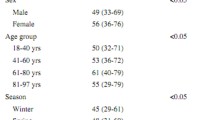Abstract
Introduction
The vast majority of older French adults exhibit some degree of hypovitaminosis D. The objective of this cross-sectional study was to determine the rate and the reasons for vitamin D prescription among older French adult community dwellers.
Methods
Vitamin D supplementation was systematically assessed among 1876 French community dwellers aged ≥65 years. Theoretical indications for vitamin D supplementation were collected, ie, the causes of hypovitaminosis D (older age, male gender, kidney failure, undernutrition, polymorbidity) or its clinical complications (vertebral or non-vertebral fractures, gait disturbances, history of falls, muscle weakness, and cognitive impairment).
Results
In total, 13.8% of the subjects (n=258) had vitamin D supplementation. They were more often malnourished (P=0.002), exhibited polymorbidity (P<0.001) and muscle weakness (P<0.001), and had a history of vertebral fractures (P<0.001), non-vertebral fractures (P<0.001), and accidental falls (P<0.001). Vitamin D supplementation was explained by the number of complications of hypovitaminosis D (odds ratio [OR]=1.61, P<0.001) including vertebral fractures (adjusted OR=1.49, P=0.007), non-vertebral fractures (adjusted OR=1.74, P=0.026), accidental falls (adjusted OR=1.44, P=0.015), and muscle weakness (adjusted OR=3.96, P<0.001), but not by the number of causes of hypovitaminosis D (P=0.464).
Conclusion
Even if vitamin D supplementation is selected well for appropriate patients, the rate of supplementation remains insufficient in France, and probably comes too late, ie, at the stage of complications of hypovitaminosis D. These findings should encourage physicians to supplement vitamin D more often and sooner in their elderly patients.
Similar content being viewed by others
References
Chapuy MC, Preziosi P, Maamer M, et al. Prevalence of vitamin D insufficiency in an adult normal population. Osteoporos Int. 1997;7:439–443.
Annweiler C, Souberbielle JC, Schott AM, De Decker L, Berrut G, Beauchet O. Vitamin D in the elderly: 5 points to remember. Geriatr Psychol Neuropsychiatr. 2011. In press.
Bruyère O, Malaise O, Neuprez A, Collette J, Reginster JY. Prévalence élevée de la carence en vitamine D chez la femme ménopausée en Europe et principalement en France: analyse d’une cohorte de 8532 sujets. Revue du Rhumatisme. 2006;73:1052. [Article in French]
Annweiler C, Schott AM, Berrut G, Fantino B, Beauchet O. Vitamin D-related changes in physical performance: a systematic review. J Nutr Health Aging. 2009;13:893–898.
Annweiler C, Allali G, Allain P, et al. Vitamin D and cognitive performance in adults: a systematic review. Eur J Neurol. 2009;16:1083–1089.
Annweiler C, Montero-Odasso M, Schott AM, Berrut G, Fantino B, Beauchet O. Fall prevention and vitamin D in the elderly: an overview of the key role of the non-bone effects. J Neuroeng Rehabil. 2010;7:50.
Nowson C. Vitamin D status of Australians: Impact of changes to mandatory fortification of margarine with vitamin D. In: Australia and New Zealand Food Authority. Canberra, 2001.
Dupuy C. Le rôle de la vitamine D dans la nutrition des sujets âgés. In: Gérontologie et société. Ed. Fondation Nationale de Gérontologie. Paris, 2010. [Article in French]
Langlois K, Greene-Finestone L, Little J, Hidiroglou N, Whiting S. Les niveaux de vitamine D chez les Canadiens selon les résultats de l’Enquête canadienne sur les mesures de la santé, 2007–2009. In: Statistique Canada, Rapports sur la santé 2010. Montréal; 2010:51–60. [Article In French]
Lorthiois J, Skowronski V, Fleury M, Gauvain JB. Screening elderly at fracture-risk eligible to a treatment. Les cahiers de l’année gérontologique. 2010;2:71–79. [Article in French]
Management strategy of protein-energy malnutrition in the elderly. French National Authority for Health (online). Available at: http://www.has-sante.fr/portail/upload/docs/application/pdf/malnutrition_elderly_guidelines.pdf. Accessed July 14, 2010.
Okumiya K, Matsubayashi K, Nakamura T, et al. The timed “up & go” test is a useful predictor of falls in community-dwelling older people. J Am Geriatr Soc. 1998;46:928–930.
Agrell B, Dehlin O. The clock-drawing test. Age Ageing. 1998;27:399–403.
Boüüaert C, Vanmeerbeek M, Burette P, et al. Vitamin D deficiency in elderly men living in urban areas, at home or in institutions. Presse Med. 2008;37:187–190.
Panneman MJ, Lips P, Sen SS, Herings RM. Undertreatment with anti-osteoporotic drugs after hospitalization for fracture. Osteoporos Int. 2004;15:120–124.
Ross AC, Manson JE, Abrams SA, et al. The 2011 report on dietary reference intakes for calcium and vitamin D from the Institute of Medicine: what clinicians need to know. J Clin Endocrinol Metab. 2011;96:53–58.
Author information
Authors and Affiliations
Corresponding author
Rights and permissions
About this article
Cite this article
Fantino, B., Beauchet, O., Savignat, S. et al. Profile of French community-dwelling older adults supplemented with vitamin D: Findings and lessons. Adv Therapy 28, 483–489 (2011). https://doi.org/10.1007/s12325-011-0030-4
Received:
Published:
Issue Date:
DOI: https://doi.org/10.1007/s12325-011-0030-4




